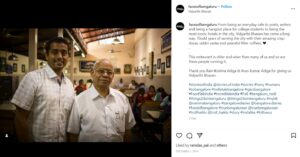A city chronicler's photoblog, Faces of Bengaluru, covers nuanced tales that rarely make it to mainstream publications.

Vikas Badiger, who runs the Faces of Bengaluru photoblog, recording nuanced stories of the city. (Supplied)
Humans of New York — a photoblog of street portraits and interviews collected on the streets of New York City — began as a passion project in the summer of 2010.
Brandon Stanton’s goal was to photograph 10,000 New Yorkers on the streets and create an exhaustive catalog of the city’s inhabitants. Unexpectedly though, the blog began to grow multifold.
Today, HONY — as Humans of New York is known — has over 20 million followers on social media and Stanton is famous worldwide.
But this story is not about him or the five boroughs of New York City. It is about a lesser-known, yet equally important metropolitan city in India, Namma Bengaluru!
Vikas Badiger, a north Bengaluru huduga (boy in Kannada), runs a project titled Faces of Bengaluru, to tell vibrant tales of the city and its people.
Born and raised in the same city, Badiger says he was inspired by HONY, and its equivalent, Humans of Bombay, initiatives. A professional photographer, he felt the need to showcase Bengaluru like never before.
“Growing up, the city always seemed so different,” he tells South First.
“We used to have so much time to do things, go for dinners, and meet friends while still focusing on academics. Most of my memories revolve around cricket. I was engrossed in becoming a cricketer in a city that has a long history of nurturing amazing athletes.”
Badiger misses the old parts of the city, where traffic was less, streets a lot quieter, and the skyline greener. “Even today, it (north Bengaluru) is a space that still feels like the olden days,” he quips.
The Faces of Bengaluru project fleshes out similar heart-warming stories and evokes strong emotions towards the city.
Thirty-year-old Badiger has a Bachelor’s degree in Commerce from a college in Seshadripuram. Raised in a conventional Indian family, Badiger says that pursuing a career in art was not encouraged.
But Badiger grew fond of photography at a young age.
“In 2008, when I was in the ninth grade, I took my mother’s cell phone on a trip to Madikeri with my uncle, aunt, and sister,” he recalls.
“While driving back, I saw the beautiful sunset and immediately took the phone out to capture the moment. I have not stopped taking photos of sunsets since then. My father saw that picture and even got it framed,” he smiles.
In 2016, Badiger bootstrapped and started Faces of Bengaluru. He says he has always been passionate about the city.
“I believe that the people in our city are culturally different. We are very individualistic and private. We like our routines and we don’t like being disturbed. And I knew back then, when I started the project, that it was going to be hard to navigate and get people to talk about themselves,” he adds.
But he took a leap of faith nonetheless.
“Most of the stories that feature on Faces of Bengaluru are stories that don’t make it to the mainstream publications,” he clarifies.

Vikas Badiger’s first story was on the owners of Vidyarthi Bhavan, an iconic eatery in Basavanagudi. (Supplied)
The first story he did was on the owners of the iconic Vidyarthi Bhavan, which whips up delicious and authentic vegetarian South Indian fare.
The restaurant, which turns 80 this year, is still relevant to Bengaluru’s old-timers. The small eatery is so much more than its supreme dosas and coconut chutneys.
“Thank you Ram Krishna Adiga & Arun Kumar Adiga for giving us Vidyarthi Bhavan,” reads the caption of this photo story.
Another feature was on a WhatsApp initiative, Kannada Gothilla (don’t know Kannada), which helps people learn the basics of the Kannada language. Anup Maiya, one of the admins of this group, collaborates with musicians and stand-up comedians, who use their talents to make learning fun.
Maiya’s project has helped several students and IT professionals who had come to Bengaluru from outside and were unfamiliar with the local language.
“We often see the place and its importance and tend to forget the people who make it iconic. Those are the kind of stories I wanted to bring out,” Badiger explains.
After 326 posts on Instagram, the page today has 15.3K followers. But Badiger thinks “it still isn’t big” as a platform.
“I am from a middle-class family and starting a project out of passion wasn’t a ‘decision’ back then. But bootstrapping it required me to take up a day job and still run my blog. In January 2020, I quit my job and shifted focus to Face of Bengaluru full-time.”
Today, the platform has expanded into making documentaries as well. These films celebrate the indomitable spirit of Bengalureans. One, Valley of Stories, is about a group of artists from the Aravani Art Project who learn photography, and document their narratives and their connection with Bengaluru.

Sharan GC, who joined Faces of Bengaluru as its Director of Photography, says people should be a part of the city’s developments. (Supplied)
Another film, Spirit Circle, is about the frisbee community in the city. The 60-minute documentary showcases how the US sport of the 1960s came to Bengaluru in the late 2000s and had solid takers.
“I believed that we had to move to the documentary space as I had a couple of ideas. And despite the Covid-19 pandemic, I continued working on our IPs through the first and second waves,” he adds.
It was also around this time that Sharan GC joined Badiger as the director of photography.
“Spirit Circle was shot during the pandemic,” Sharan tells South First. “I had known Vikas through our common photography circle. We spoke about the new sport, Ultimate Frisbee, and thought why not make a documentary on its origin.”
Thou Shalt Not Steel, yet another documentary, featured one of the biggest citizen-led protests in Bengaluru. In October 2016, several Bengalureans formed a human chain to mark their opposition to the proposed steel flyover in the city.
“This film is all about the people of Bengaluru standing up for the right cause irrespective of whom they are going against. Projects like the steel flyover will keep happening, but choosing why we need it and its effects are in the hands of people. This documentary helps people understand why it’s important to be a part of the developments taking place in the city,” Sharan adds.
When asked to pick his favourite from the photoblog series, Badiger says he was “moved” by the stories of security guards during the first wave of the pandemic.
“We had first responders and doctors, but these watchmen were standing alone and guarding the whole building. A few of them told us it was lonely, and they had very few people to talk to. After posting their stories, some of our readers around the area visited them and had quick chats to keep them entertained,” Badiger smiles.
Badiger wants to continue taking this project to new heights. “It has been a rollercoaster of a journey,” he says. “We want to tell these real-life human stories to the world in its truest form. That is our goal.”

Jul 17, 2024

Jul 16, 2024

Jul 13, 2024

Jul 08, 2024

Jun 07, 2024

Jun 07, 2024